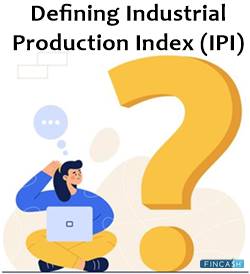What is the Industrial Production Index?
The Industrial Production Index (IPI) is an Economic Indicator that measures the growth rate in the Manufacturing, electric, mining, and gas industries over a period of time. It is compiled and published monthly by the Central Statistical Organisation (CSO) under the "Ministry of Statistics and Programme Implementation."

It calculates the data of eight core sectors, including crude, natural gas, coal, cement, fertilizers, electricity, steel, and refinery products, that makeup 40% of the items included in IPI.
How does the Industrial Production Index work?
Industrial Product Index is used to calculate the levels of production in different economic sectors of the country. Moreover, it also measures the capacity, i.e., the level of output that a company can sustainably maintain and the Capacity Utilization Rate, the ratio of the company's actual output to capacity or potential. You can find the rate using the given formula:
(Actual output/ potential output) X 100 = Capacity utilization rate
Here, an answer of less than 100% indicates that the company is not producing at its full potential.
Components of IPI
The IPI constituents fall under three main categories – Mining (14.4%), manufacturing (77.6%), and electricity (8%). These are further classified into eight core sectors, including a total of 407 item groups under the 2011-12 series. Herein, each group may have various sub-industries.
Talk to our investment specialist
Use of IPI
Industrial Production Interest is useful for government agencies like the Finance Ministry and Reserve Bank of India (RBI) in the policymaking process. Besides, it is extremely useful in calculating quarterly and advanced Gross Domestic Product (GDP) estimates. Industry-level data is also used by business analysts, financial experts, and investors within different sectors of business for varied purposes. For example, the data released after the Market hours is greatly followed by several stock market analysts to understand the economic momentum.
Change in the Base Year
A Base Year can be described as the first year or base point in a time of series, which is usually set to a level of 100. It is used to compare the business activities or economic index in various sectors.
The change in IPI base year from 2004-5 to 2011-12 happened in 2017. This was the ninth revision of the IPI base year since 1950. In the new 2011-12 IPI data series, 149 items were added (including cement clinkers, refined palm oil, and surgical accessories and 124 were deleted (including toothbrushes, chewing tobacco, pens, fans, calculators, and watches).
Annual Survey of Industries (ASI) and Industrial Production Interest (IPI)
While IPI is a monthly economic indicator, ASI is the primary source of long-term industrial statistics. The ASI is a record-based index that is based on a much larger sample of industries as compared to IPI. Therefore, when it comes to annual revised estimates, the CSO replaces IPI with ASI for better insights into the Economy.
Takeaway
Industrial Production Index is the key economic indicator in determining the growth rate of manufacturing, electricity, and mining industries. IPI is published monthly with a lag of six weeks after the reference month. IPI is the only measure of physical volume of production that is used to calculate the industrial growth level in the economy.
All efforts have been made to ensure the information provided here is accurate. However, no guarantees are made regarding correctness of data. Please verify with scheme information document before making any investment.












